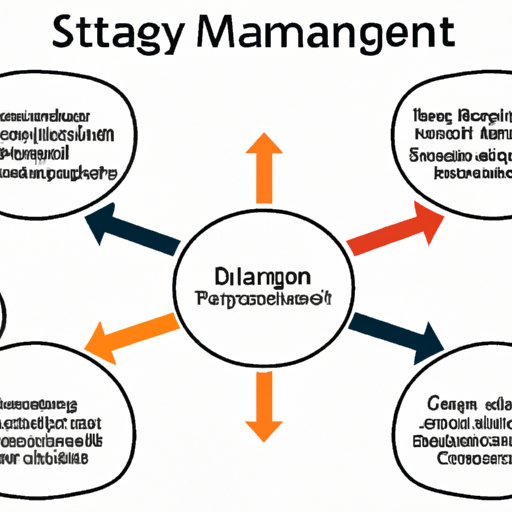Introduction
When it comes to running a successful business, having a well-thought-out strategy is essential. But what exactly is strategy in business? In its simplest form, strategy can be defined as “a plan of action designed to achieve a specific goal.” It involves making decisions about how to allocate resources and use them to gain a competitive edge over other businesses.
However, there is much more to strategy than simply having a plan. To really succeed, businesses need to understand the different types of strategies available, the components of a successful strategy, and how to develop and implement an effective strategic plan.
Exploring Different Types of Business Strategies
There are several different types of business strategies that can be used to achieve success. Here are some of the most common:
Cost Leadership Strategies
Cost leadership strategies involve offering products or services at a lower cost than competitors. This can be done by reducing costs through economies of scale or by cutting expenses. The goal is to attract customers with lower prices while still making a profit.
Differentiation Strategies
Differentiation strategies involve creating unique products or services that set a business apart from its competitors. This can be done through innovation, quality, customer service, or branding. The goal is to give customers a reason to choose your business over others.
Focus Strategies
Focus strategies involve targeting a specific market segment or niche. This can be done by offering specialized products or services that meet the needs of a particular group of customers. The goal is to become the leader in that market segment.
Growth Strategies
Growth strategies involve expanding a business’s operations into new markets or introducing new products or services. This can be done through organic growth (internal expansion) or through acquisitions (external expansion). The goal is to increase revenues and profits.
Understanding the Components of a Successful Business Strategy
Developing a successful business strategy requires understanding the key components of a successful strategy. These include:
Setting Clear Goals
It’s important to have a clear understanding of what you want to accomplish with your business strategy. Setting measurable goals will help you track progress and ensure that you’re on the right path to success.
Developing an Effective Vision
An effective vision statement should provide guidance and direction for your business. It should be short and concise, but also inspiring and motivating.
Identifying Resources and Competitors
It’s important to understand the resources you have available and who your competitors are. This will help you identify opportunities and threats and develop strategies to capitalize on them.
Analyzing Market Trends
Analyzing market trends is critical for developing an effective business strategy. Understanding current and future trends can help you anticipate customer needs and stay ahead of the competition.

Developing an Effective Strategic Plan
Once you’ve identified the components of a successful business strategy, it’s time to develop a strategic plan. This plan should include:
Defining Objectives
Your objectives should be clear and achievable. They should be based on your goals and aligned with your vision.
Creating Action Plans
Action plans should outline the steps needed to reach each objective. They should include timelines, resources, and responsibilities.
Making Decisions
Decisions should be based on data and careful analysis. They should also take into account the potential risks and rewards.
Allocating Resources
Resources should be allocated based on the action plans and objectives. This includes financial, human, and technological resources.

A Guide to Implementing Your Business Strategy
Once you’ve developed your strategic plan, it’s time to move on to implementation. Here are some tips for getting started:
Planning for Change
Implementing a new strategy requires planning for change. This includes training employees, communicating the new strategy, and preparing for potential resistance.
Communicating Your Strategy
It’s important to communicate your strategy clearly and effectively. This includes providing employees with information about the strategy and why it’s important.
Establishing Performance Metrics
Performance metrics should be established to measure progress. This will help you determine whether the strategy is working and make adjustments as needed.
Monitoring Progress
Progress should be monitored regularly to ensure that the strategy is being implemented correctly and achieving the desired results.

Evaluating and Adjusting Your Business Strategy for Maximum Performance
Once your strategy has been implemented, it’s important to evaluate and adjust it as needed. Here are some tips for doing so:
Reviewing Performance
It’s important to review performance regularly to ensure that the strategy is meeting the desired objectives. This can be done through surveys, customer feedback, and other methods.
Refining Action Plans
Action plans should be refined as needed to ensure that they are still aligned with the overall strategy and objectives.
Making Necessary Changes
Changes should be made when necessary to ensure that the strategy is still on track. This could involve changes to resources, personnel, or tactics.
Tracking Results
Results should be tracked regularly to ensure that the strategy is achieving the desired outcomes. This could include tracking sales figures, customer satisfaction, and other metrics.
Conclusion
Having a well-thought-out strategy is essential for any successful business. Understanding the different types of strategies, the components of a successful strategy, and how to develop and implement an effective strategic plan are all important steps to achieving success. Additionally, it’s important to evaluate and adjust your strategy as needed to ensure that it is performing at its best.
(Note: Is this article not meeting your expectations? Do you have knowledge or insights to share? Unlock new opportunities and expand your reach by joining our authors team. Click Registration to join us and share your expertise with our readers.)
